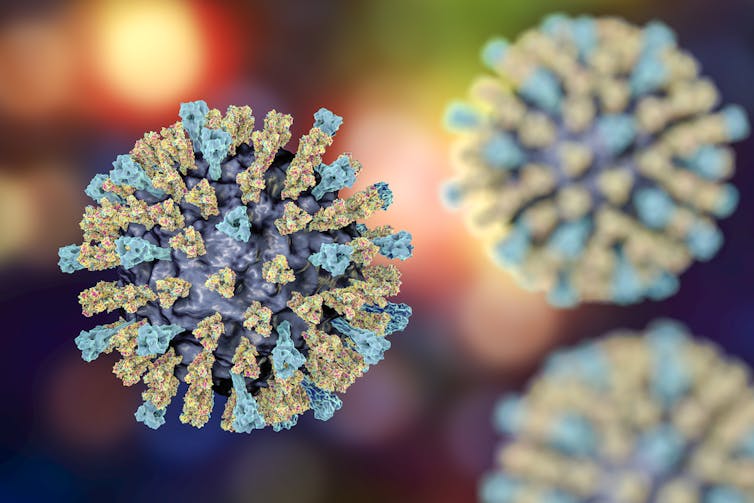4 of our greatest achievements in vaccine science (that led to COVID vaccines)
- Written by Adam Taylor, Early Career Research Leader, Emerging Viruses, Inflammation and Therapeutics Group, Menzies Health Institute Queensland, Griffith University
All eyes are on COVID-19 vaccines, with Australia’s first expected to be approved for use shortly.
But their development in record time, without compromising on safety, wouldn’t have been possible without the development of other vaccines before them.
These existing vaccines are some of the greatest achievements of medical science, preventing the spread of infectious disease, saving millions of lives around the world each year.
Here’s what we’ve learned from other vaccines over the past 200 years or so that allowed us to go from discovery of the virus we now know as SARS-CoV-2, to regulatory approval in some countries in less than a year.
1. Smallpox
Vaccination as we know it started over 200 years ago. Edward Jenner, an English physician, noticed people exposed to cowpox virus, which caused only mild illness, were protected from the severe disease caused by smallpox.
Cowpox and smallpox are part of the poxvirus family. Both share characteristics the immune system recognises. By inoculating people with cowpox, Jenner produced cross-protection against smallpox infection.
With successive development of smallpox vaccines, in 1979 smallpox became the first human infectious disease to be eradicated by vaccination.
Read more: A short history of vaccine objection, vaccine cults and conspiracy theories
2. Polio
Poliovirus is a highly infectious virus that spreads through close contact with infected people, particularly in areas with poor hygiene. Infection can lead to paralysis, typically affecting infants.
The first widely used polio vaccines were developed in the 1950s using newly available methods, known as tissue culture, to grow the virus in the lab.
Tissue culture allowed researchers to grow and inactivate poliovirus, or grow a live form of the virus that was attenuated (or weakened), to form the basis of vaccines that could be given orally. These were distributed in the late 50s.
Researchers still use variants of these early tissue culture techniques to research and develop vaccines today.
The success of mass vaccination in developed countries led to the launch of the Global Polio Eradication Initiative. Poliovirus is now close to global eradication with only two countries (Afghanistan and Pakistan) reporting low numbers of new infections.
Read more: Explainer: ridding the world of polio
3. Measles
The measles virus is highly contagious, and is spread by through the air when someone coughs and sneezes, as well as via direct contact with fluid from a person’s coughs or sneezes.
Before the development of a measles vaccine in 1963, measles was one of the most lethal infectious agents, causing an estimated 2.6 million deaths each year.
In Australia, the vaccine can be given with mumps, rubella and varicella (chickenpox) vaccines to give the combination MMRV vaccine.
 Measles virus killed millions of people each year before there was a vaccine.
www.shutterstock.com
Measles virus killed millions of people each year before there was a vaccine.
www.shutterstock.com
Global action to eliminate measles via vaccination resulted in a 73% drop in measles deaths worldwide between 2000 and 2018.
Despite this, global coverage of measles vaccines is not enough to prevent outbreaks. Deaths from measles rose from 140,000 in 2018 to 207,500 in 2019.
And in many countries, including Australia, measles outbreaks continue to occur in areas where vaccination rates have fallen.
Engineered versions of the measles vaccine are now being developed to deliver pieces of other viruses, including dengue and HIV, into the body to generate a protective immune response.
Read more: Measles in Samoa: how a small island nation found itself in the grips of an outbreak disaster
4. Diphtheria, tetanus and pertussis (whooping cough)
Diphtheria, tetanus and pertussis (or whooping cough) are three separate diseases all caused by different bacteria.
Inactivated toxins produced by these bacteria, and pieces of the bacteria that are safe and mount an effective immune response, have been used since the 1940s in combination to vaccinate against all three diseases.
The diphtheria, tetanus and pertussis (DTP) vaccine was the first combination vaccine. In other words, it was the first vaccine to prevent against multiple diseases. Combination vaccines continue to provide benefits to immunisation schedules by reducing the number of injections required.
These DTP combination vaccines are part of the Australian National Immunisation Program Schedule, and further vaccines have since been added to the mix.
DTP vaccines can now be delivered as a single injection with Haemophilus influenzae type b and poliovirus vaccine. Other combination DTP-based vaccines are also available.
Read more: Vaccines to expect when you're expecting, and why
Which brings us to COVID-19
On January 10, 2020, Chinese and Australian scientists provided open access to the newly discovered genetic sequence of the novel coronavirus we now know as SARS-CoV-2.
Australian scientist Eddie Holmes then tweeted a link to the SARS-CoV-2 genome:
This simple act of open science kick-started vaccine development at a rapid pace. On December 2, less than a year later, the Pfizer vaccine became the first fully-tested COVID-19 vaccine to be approved for emergency use, in the UK.
Read more: What do we know about the Novavax and Pfizer COVID vaccines that Australia just signed up for?
What’s next?
Despite extensive efforts to develop vaccines, diseases such as malaria and tuberculosis still kill millions of people each year.
As we enter the next generation of vaccine design, we can look forward to trialling technologies such as mRNA vaccines, which clinical trials show to be successful against COVID-19, to combat other diseases of global importance.
Authors: Adam Taylor, Early Career Research Leader, Emerging Viruses, Inflammation and Therapeutics Group, Menzies Health Institute Queensland, Griffith University





